
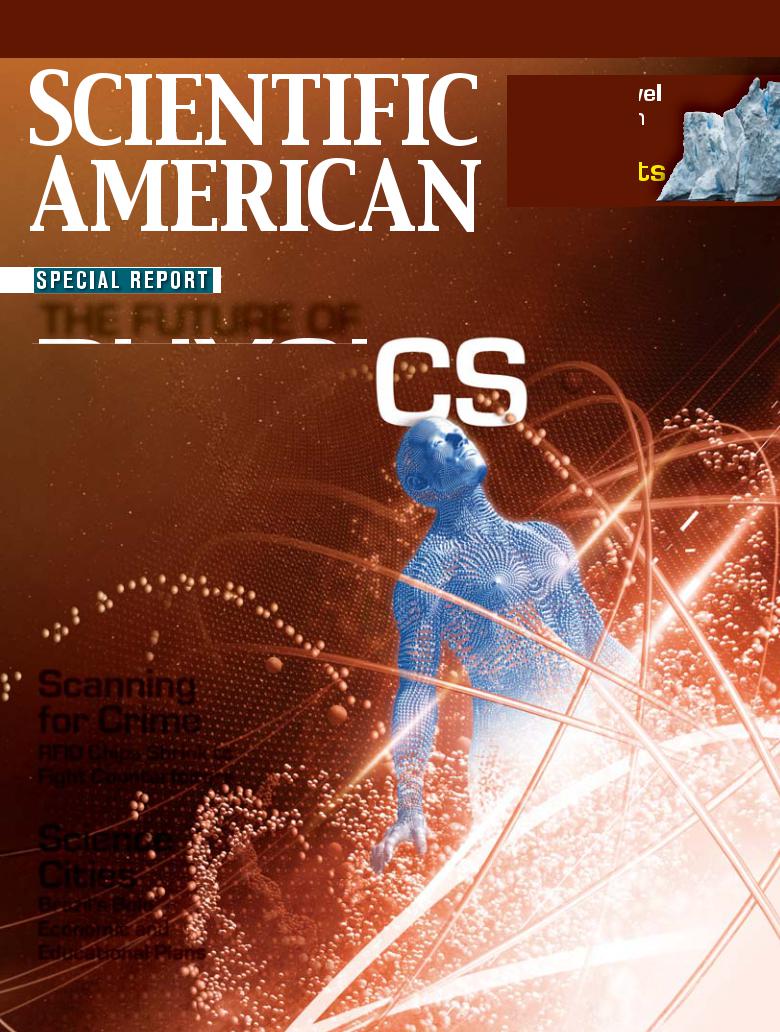
Cellular Invaders: Who Is Inside You? (page 72)
The Sea-Level
Threat from
Sliding
Ice Sheets
page 60
|
February 2008 |
www.SciAm.com |
|
|
|
|
|
|
THE FUTURE OF
PHYSI
Hidden natural laws? Unseen dimensions? Two new particle colliders will search for answers at unimaginable energies
Scanning for Crime
RFID Chips Shrink to Fight Counterfeiters
Science
Cities
Brazil’s Bold
Economic and
Educational Plans
© 2008 SCIENTIFIC AMERICAN, INC.
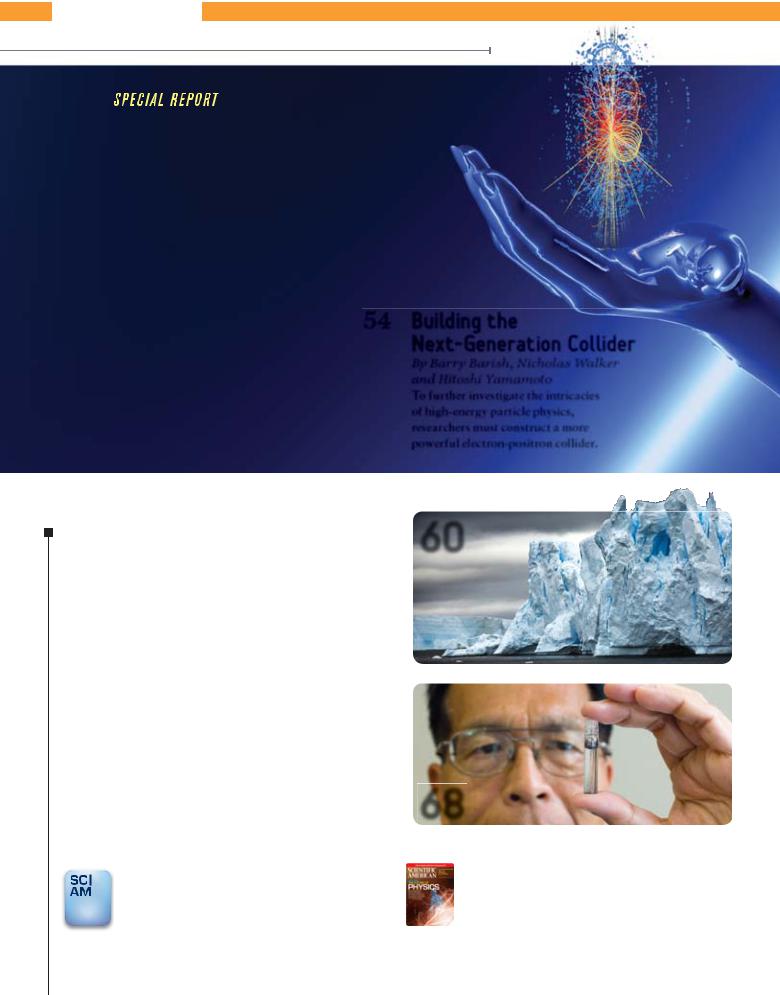
FEATURES ■
SCIENTIFIC AMERICAN February 2008 ■ Volume 298 Number 2
38 The Future of Physics
39 |
The Discovery Machine |
|
|
|
By Graham P. Collins |
|
|
|
The Large Hadron Collider, the biggest and |
|
|
|
most complicated particle physics experiment |
|
|
|
ever seen, is nearing completion and is |
|
|
|
scheduled to start colliding protons this year. |
|
|
46 |
The Coming Revolutions |
54 |
Building the |
|
in Particle Physics |
||
|
|
Next-Generation Collider |
|
|
By Chris Quigg |
|
|
|
No matter what the Large Hadron |
|
By Barry Barish, Nicholas Walker |
|
Collider finds, it is going to take physics |
|
and Hitoshi Yamamoto |
|
into new territory. |
|
To further investigate the intricacies |
|
|
of high-energy particle physics, |
|
|
|
|
|
|
|
|
researchers must construct a more |
Image by CERN and Phil Saunders/Space Channel Ltd. |
|
powerful electron-positron collider. |
|
CLIMATE CHANGE |
60 |
60 The Unquiet Ice |
|
By Robin E. Bell |
Abundant liquid water discovered underneath the great polar ice sheets could catastrophically intensify the effects
of global warming on the rise of sea level around the world.
INNOVATIONS
68 RFID Powder
By Tim Hornyak |
|
|
|||
Radio-frequency identification (RFID) tags label |
|
|
|||
all kinds of inventoried goods and speed commuters |
|
|
|||
through toll plazas. Now tiny RFID components |
68 |
||||
are being developed with a rather different aim: |
|||||
thwarting counterfeiters. |
|||||
|
|
||||
SHARE YOUR THOUGHTS |
|
ON THE COVER |
|||
|
|
|
|
|
|
Post your comments about articles in this issue for the benefit of other readers.
Go to www.SciAm.com/ontheweb
w w w. SciAm .com
The Large Hadron Collider and a proposed International Linear Collider should propel humankind into a pristine realm of unknown particle physics. Image by Kenn Brown.
SC IE NTIFIC AMERIC AN 1
© 2008 SCIENTIFIC AMERICAN, INC.
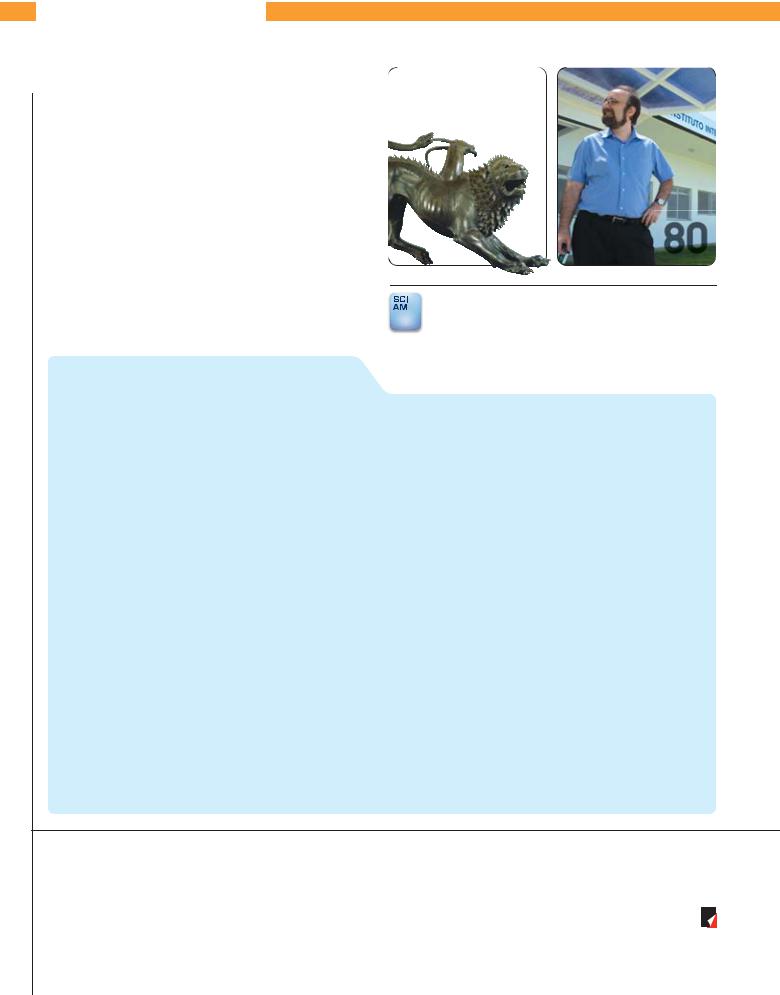
MORE FEATURES ■
MEDICINE
 72 Your Cells Are My Cells
72 Your Cells Are My Cells
By J. Lee Nelson
Many, perhaps all, people harbor a small number of cells from genetically different individuals—from their mothers and, for women who have been pregnant, from their children. What in the world do these foreigners do in the body?
SCIENCE AND SOCIETY
80 Building a Future on Science
By Christine Soares
Brazilian neuroscientist Miguel A. L. Nicolelis taps into the chatter of neurons to drive robotic prosthetics. Now he hopes to tap the potential of his country’s population by building a network of “science cities.”
72
80
Science Cities
Learn more about how research centers might help developing nations. Go to www.SciAm.com/ontheweb
GO TO 

 .COM
.COM
ROBOT ROACHES RALLY REAL ROACHES Ç
Tiny robotic roaches were able to inßuence the collective behavior of real ones, pointing the way to more sophisticated machine-animal interactions of the future. More at www.SciAm.com/ontheweb
COURTESY OF FREE UNIVERSITY OF BRUSSELS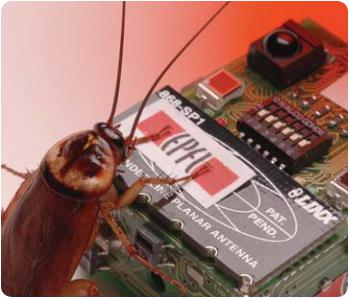
8In Focus
Beyond the Worst-Case Climate Change Scenario The IPCC has declared man-made climate change Òunequivocal.Ó The hard part: trying to stop it.
8News
Partial Recall: Why Memory Fades with Age The disruption of white matter conduits
in the aging brain keeps its regions from communicating effectively.
8Podcast
Dark Stars Bigger Than Solar Systems?
Early stars partially composed of dark matter may have been too bloated for fusion.
8Video
What Is Dark Matter?
Our new video podcast kicks off with a quick take on the stuff that makes up most of the mass in the universe.
8Join the Community
http://science-community.SciAm.com
Start a blog, share your photos and comment on articles at the new SciAm Community.
Scientific American (ISSN 0036-8733), published monthly by Scientific American, Inc., 415 Madison Avenue, New York, N.Y. 10017-1111. Copyright © 2008 by Scientific American, Inc. All rights reserved. No part of this issue may be reproduced or transmitted in any form or by any means, electronic or mechanical, including photocopying and recording for public or private use, or by any information storage or retrieval system, without the prior written permission of the publisher. Periodicals postage paid at New York, N.Y., and at additional mailing offices. Canada Post International Publications Mail (Canadian Distribution) Sales Agreement No. 40012504. Canadian BN No. 127387652RT; QST No. Q1015332537. Publication Mail Agreement #40012504. Return undeliverable mail to Scientific American, P.O. Box 819, Stn Main, Markham, ON L3P 8A2. Subscription rates: one year $34.97, Canada $49 USD, International $55 USD. Postmaster: Send address changes to Scientific American, Box 3187, Harlan, Iowa 51537. Reprints available: write Reprint Department, Scientific American, Inc., 415 Madison Avenue, New York, N.Y. 10017-1111; (212) 451-8877; 
 fax: (212) 355-0408. Subscription inquiries: U.S. and Canada (800) 333-1199; other (515) 248-7684. Send e-mail to sacust@sciam.com Printed in U.S.A.
fax: (212) 355-0408. Subscription inquiries: U.S. and Canada (800) 333-1199; other (515) 248-7684. Send e-mail to sacust@sciam.com Printed in U.S.A.
2 SC IE NTIFIC AM E RIC AN |
Februar y 20 0 8 |
© 2008 SCIENTIFIC AMERICAN, INC.
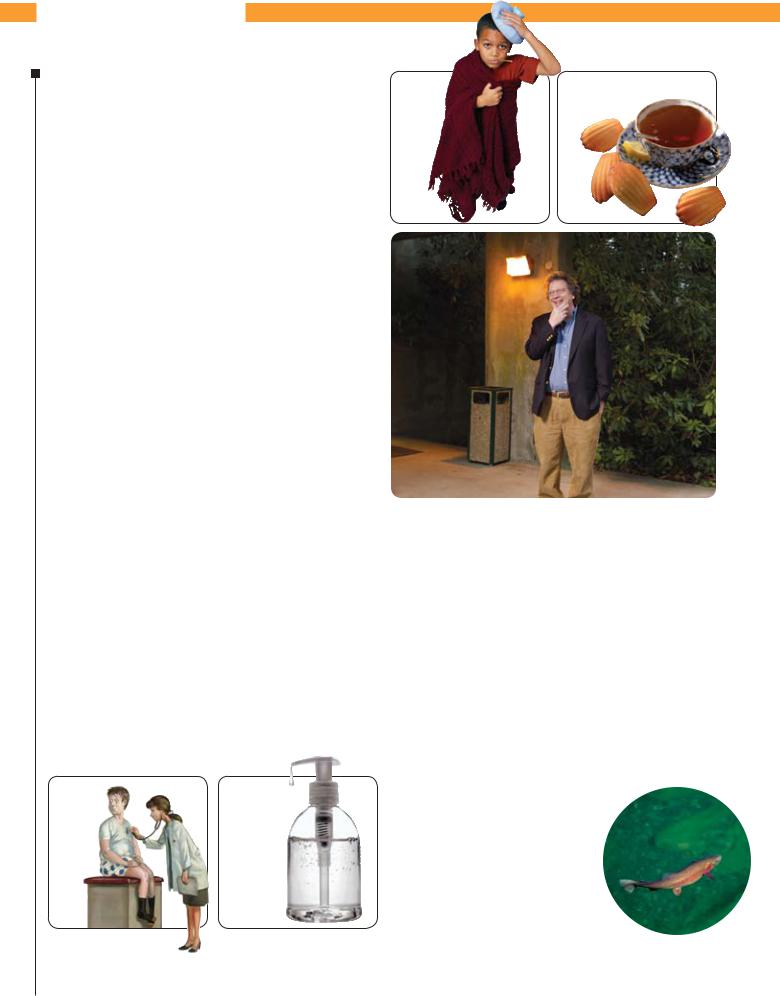
DEPARTMENTS ■
6 From the Editor
8Letters
12 50, 100 and 150 Years Ago
14 Updates
16NEWS SCAN
■A replacement for embryonic stem cells.
■Building a tech mecca.
■Huntington’s odd connections.
■Plasma for stealthy antennas.
■Ethnicity-based medicine retooled.
■Competition improves military technology.
■Is glaucoma screening worthwhile?
■Data Points: Vaccine track record.
32 |
OPINION |
|
■ |
SciAm Perspectives |
|
|
|
|
|
Reform health care: cut unneeded technology. |
|
33 |
■ |
Forum |
|
||
|
By Luiz Inácio Lula da Silva, |
|
|
Fernando Haddad and Miguel A. L. Nicolelis |
|
|
A new nationwide education plan will allow Brazil |
|
|
to reach its full potential. |
|
34 |
■ |
Sustainable Developments |
|
||
|
By Jeffrey D. Sachs |
|
|
Sound economic solutions, not military ones, offer the |
|
|
most reliable route to peace for undeveloped nations. |
|
35 |
■ |
Skeptic |
|
||
|
By Michael Shermer |
|
|
Evolutionary economics explains irrational choices. |
|
37 |
■ |
Anti Gravity |
|
||
By Steve Mirsky
Remembrance of things future.
32
96
4 SC IE NTIFIC AMERIC AN
14 92
86
BRIAN MARANAN PINEDA
86 Insights
Autistic people generally do not have children, so why do autism genes persist? Michael Wigler thinks that he knows.
90 Working Knowledge
The video magic of blue screen.
92 Reviews
Oil vs. autos. Science imitates art.
94 Ask the Experts
How do the same fish species end up so far apart?
How does Bluetooth work?
96 Fact or Fiction?
Do antibacterial soaps do more harm than good?
94
Februar y 20 0 8
© 2008 SCIENTIFIC AMERICAN, INC.

FROM THE EDITOR ■
Among Our
Contributors
ROBIN E. BELL
investigates ice-sheet collapse and directs the ADVANCE program at the Earth Institute at Columbia University. She is also a leader in planning for the International Polar Year.
TIM HORNYAK
covers new developments in science and technology from his home base in Tokyo. He is the author of the book
Loving the Machine: The Art and Science of Japanese Robots.
J. LEE NELSON
has been studying the medical implications of microchimerism for more than two decades. She
is currently a professor of medicine at the University of Washington.
CHRIS QUIGG
of Fermi National Accelerator Laboratory studies supercollider physics, with a particular emphasis on the symmetry breaking that should occur at terascale energies.
6 SC IE NTIFIC AME RIC AN
 Presidential Science
Presidential Science
Aspirants to the White House should publicly debate their views on science policy
Consider this partial list of issues that the next president of the U.S. will need to address: reducing greenhouse gas emissions; ensuring fresh-
water supplies; encouraging reliance on renewable energy sources; preparing for pandemics; developing stem cell technologies; improving science education; stimulating technological innovation.
How many of the current candidates for the presidency have stated clear positions on those subjects? What reasons would they give for their stances, and how well could they defend them? The answers could be broadly illuminating. The policies of the U.S. on such matters will be earthshakingly important in the
years ahead, yet the candi dates’ intentions toward them have come in for little sustained attention thus far.
One of the more no-
torious moments of the |
|
|
campaign season oc- |
|
|
curred last May during |
|
|
a debate among the Re- |
WILL THEY DEBATE |
|
publican candidates, |
||
|
when three of them went on the record as not believing in the theory of evolution. Voters are undoubtedly better off knowing that to be true. It is at least as important, however, to know how all the candidates would set science priorities and direct technology to positive ends.
In December a grassroots bipartisan movement of concerned citizens operating as Science Debate 2008 issued a call for a debate that would focus exclusively on issues relating to the environment, health and medicine, and science and technology policy. Twelve Nobel laureates and other scientists are among the signatories to the petition, but so, too, are sitting congressional representatives, former presidential science advisers, business leaders and others (the list is still growing as this goes to
press). Support has come swiftly from both Republicans and Democrats, as it should. I signed the petition on behalf of
Scientific American and serve on the organization’s steering committee. Readers can learn more about the effort online at www.sciencedebate2008.com.
A similar proposal for a “town hall” on science circulated during the 2004 presidential election, but it faltered. Here’s hoping that this time the idea finds more traction with the campaigns. Our nation cannot afford to elect a president who is ill informed or dismissive about the role of science in making the world’s future secure and bright.
Outside the U.S., at least one president positively glories in what science can do for his country. In her article “Building a Future on Science” (see page 80), staff editor Christine Soares de-
|
scribes the visionary |
|
|
plan that originated |
|
|
with neuroscientist |
|
|
Miguel A. L. Nicolelis |
|
over science? |
of Duke University to |
|
promote economic de- |
||
|
velopment in a poor region of Brazil by establishing a new “science city” there. Centering on a well-financed research institution, such a cluster would cultivate the regional economy and raise the quality of local science education dramatically. Luiz Inácio Lula da Silva, president of Brazil, has become an enthusiastic supporter of this concept. In the Forum essay on page 33, Lula da Silva, Nicolelis and Fernando Haddad, Brazil’s minister of education, announce a new initiative based on this concept that will extend science education and teacher training throughout the nation. We salute their enterprise and wish them well with this bold experiment. ■
JOHN RENNIE editor in chief
Februar y 20 0 8
© 2008 SCIENTIFIC AMERICAN, INC.
FLYNN LARSEN (Rennie); ETHAN MILLER Getty Images (debate)

®
Established 1845
E D ITO R I N C H I E F : John Rennie
E X EC U TI V E E D ITO R : Mariette DiChristina
M A N AG I N G E D I TO R : Ricki L. Rusting
C H I E F N E WS E D ITO R : Philip M. Yam SE N IOR W RITE R : Gary Stix
E D ITO RS : Mark Alpert, Steven Ashley, Peter Brown, Graham P. Collins, Mark Fischetti, Steve Mirsky, George Musser, Christine Soares
CO N TRI B U TI NG E D ITO RS : W. Wayt Gibbs,
Marguerite Holloway, Michelle Press, Michael Shermer, Sarah Simpson
E D I TO R I A L D I R EC TO R , O N L I N E : Kate Wong N E WS E D ITO R , O N LI N E : Lisa Stein
A SSOC I ATE E D ITO RS , O N LI N E : David Biello, Larry Greenemeier
SPEC I A L PROJ EC T S E D ITO R , O N LI N E :
Christopher Mims
N E WS RE PO R TE RS , O N LI N E : JR Minkel,
Nikhil Swaminathan
CO M M U N IT Y E D ITOR , ON LI N E : Christie Nicholson A R T D I R EC TO R , O N LI N E : Ryan Reid
A R T D I R EC TO R : Edward Bell
A SSOC I ATE A R T D I REC TO R : Mark Clemens A SSI STA N T A R T D I REC TO R : Johnny Johnson A SSI STA N T A R T D I REC TO R : Jen Christiansen PHOTOG R A PH Y E D ITO R : Emily Harrison PRO D UC TI O N E D ITO R : Richard Hunt
COPY D I REC TOR : Maria-Christina Keller COPY C H I E F : Daniel C. Schlenoff
CO PY A N D R E S E A RC H : Michael Battaglia, John Matson, Aaron Shattuck, Rachel Dvoskin, Smitha Alampur, Michelle Wright
E D ITO RI A L A D M I N I STR ATO R : Jacob Lasky
SE N IOR SEC RE TA RY: Maya Harty
A SSOC I ATE PU B LI SH E R , PRO D UC TIO N :
William Sherman
M A N U FAC T U RI NG M A N AG E R : Janet Cermak ADVERTISING PRODUCTION MANAGER : Carl Cherebin PRE PR E SS A N D Q UA LI T Y M A N AG E R : Silvia De Santis PRODUCTION MANAGER : Christina Hippeli
C USTO M PU B LI SH I NG M A N AG E R :
Madelyn Keyes-Milch
BOARD OF ADVISERS
RITA R. COLWELL
Distinguished Professor, University of Maryland
College Park and Johns Hopkins Bloomberg School
of Public Health
DANNY HILLIS
Co-chairman, Applied Minds
VINOD KHOSLA
Founder, Khosla Ventures
M. GRANGER MORGAN
Professor and Head of Engineering and Public
Policy, Carnegie Mellon University
LISA RANDALL
Professor of Physics, Harvard University
GEORGE M. WHITESIDES
Professor of Chemistry, Harvard University
8 SC IE NTIFIC AMERIC AN
LETTERS ■
editors@SciAm.com
Drug Access ■ Conservation Strategy ■ Consciousness
“The difficulty in evaluating the health of a terminal cancer patient makes it very hard, in my opinion, to easily demonstrate the real benefit that a drug may show in a relatively healthier patient.”
—Joe Senesac HOUSTON
OCTOBER 2007
■ Drug Dilemma
Beryl Lieff Benderly does an excellent job of summarizing the current state of the environment for access to experimental cancer drugs in “Experimental Drugs on Trial.” A bigger issue that Benderly does not discuss, however, regards how the U.S. Food and Drug Administration and other regulatory agencies evaluate medicines for terminal disease states, particularly cancer.
Built into the evaluation process is the assumption that the truly sick individuals allowed to participate in clinical studies generate treatment data that are directly relevant to earlier-stage patients. Although this may be the case in many situations, it is used as a truism that is perhaps unprovable. The difficulty in evaluating the health of a terminal cancer patient makes it very hard, in my opinion, to demonstrate the real benefit that a drug may show in a relatively healthier patient.
We then encounter the ethical dilemma of whether to permit earlier-stage patients, who have more established treatment options, to use an experimental drug that has at least the potential to help them more than current (and painful) chemotherapy and radiation treatments. If we could find a way to allow earlier-stage patients access to experimental medicines that is ethical and that helps society as a whole, we might speed cancer drug development immensely.
Joe Senesac
Houston
■ Political Wilderness
In “Conservation for the People,” Peter Kareiva and Michelle Marvier make the case that, because conservationists have not been able to build strong political support for protecting areas based on their biodiversity value, focus should instead be given to protecting areas that provide immediate benefits for people.
As in other political and social movements, failure to build support for a goal does not mean it should be abandoned. If the movements for abolition or civil rights had adopted Kareiva and Marvier’s ap- proach—making available to black Americans only such freedom and equality as whites saw as being in their near-term material interest—we would still be living with Jim Crow.
The authors drag out many straw men in making their argument, including the nonexistence of “pristine wilderness.” Wilderness need not be pristine to sustain all native species in healthy populations, including top predators—animals essential to healthy ecosystems that some find “inconvenient.” Wild places are essential because people’s ability to manage nature successfully is limited. Experimentation with different approaches to conservation is fine but not at the expense of efforts to protect the lands and waters vital to the full range of biodiversity.
David Johns |
Michael E. SoulŽ |
School of Government |
Professor emeritus |
Portland State |
University of California, |
University |
Santa Cruz |
Februar y 20 0 8
© 2008 SCIENTIFIC AMERICAN, INC.
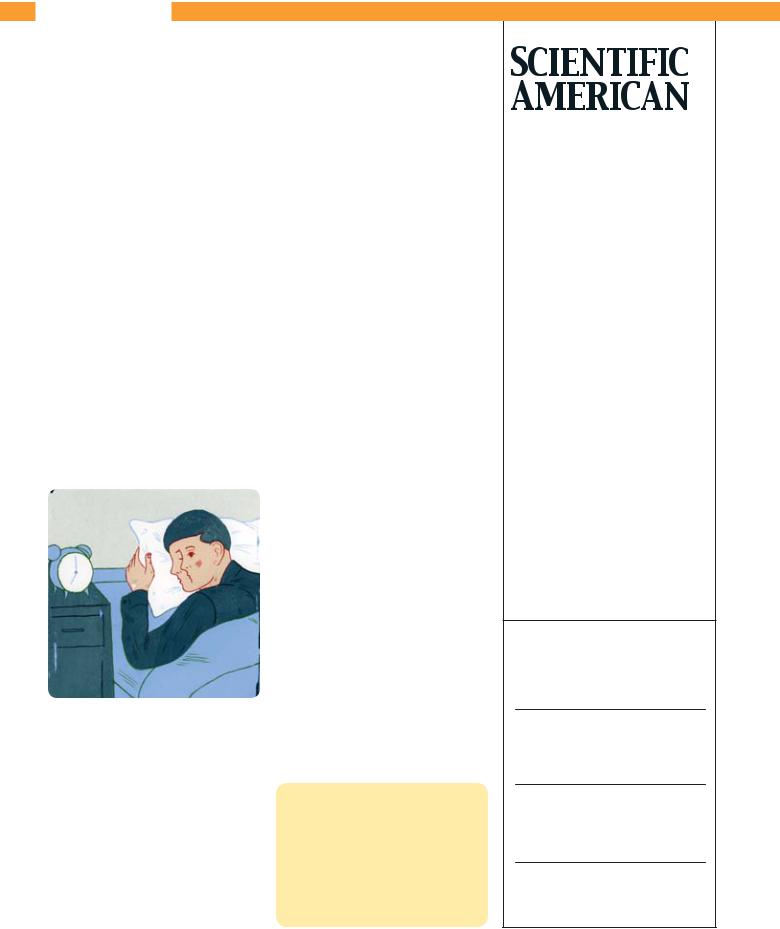
LETTERS ■
■ Pillow Perception?
In explaining their different theories of what brain activity matches up with specific conscious experiences in “How Does Consciousness Happen?” Christof Koch and Susan Greenfield each describe their views on why an alarm clock induces “consciousness” in a sleeping individual. Both fail to consider several factors in their assessments, and I feel that a better understanding of where “unconsciousness” ends and consciousness begins is needed.
For instance: Why is it that a person can sleep peacefully through many “common” sounds yet suddenly wake to the slightest “uncommon” noise? When I awaken to such sounds, I am more fully “conscious,” or acutely aware of my surroundings, than if I am suddenly woken from sleep by the shrill call of the alarm clock. Furthermore, many people invariably awaken a few minutes before their alarm clock sounds.
All this suggests a rather high degree of consciousness and awareness of one’s surroundings while sleeping.
Garry Wainscott
Perth, Australia
OF TWO MINDS: Christof Koch and Susan Greenfield disagree on what neuronal activity occurs during subjective experience.
■ Blastoff Bias?
“To the Moon and Beyond,” by Charles Dingell, William A. Johns and Julie Kramer White, posits NASA’s Orion space vehicle as a possible basis for a manned craft capable of traveling to Mars. The authors are all employees of NASA or Lockheed Martin (the lead contractor on the project), and this article represents a disturbing trend of presenting press releases or puff
10 SC IE NTIFIC AME RIC AN
pieces as articles with journalistic integrity. A serious article on this project could have been written by a real science journalist, who would have weighed the claims of the NASA staff.
Gil Hennessey
New York City
■ The Hard Stuff
In “The Really Hard Science” [Skeptic], Michael Shermer laments the practice of labeling different fields of science as “hard” or “soft,” with “hard” sciences respected as being more “difficult.” This view is one I had not considered. I always saw physics and math as “hard,” not because they are considered more difficult but because they can be somewhat constrained. The “soft” sciences are less possible to constrain— their “laws” are more subject to interpretation and harder to confirm experimentally. Computing a planetary orbit can be carried to many decimal places with accuracy. Determining the level of anger in a given population can only be computed with statistical uncertainty. The latter is probably more difficult and the former more reliable.
Richard Podraza
via e-mail
ERRATUM “Experimental Drugs on Trial,” by Beryl Lieff Benderly, refers to a case being heard in March 2007 by the full nine-member U.S. Circuit Court of Appeals for the District of Columbia. There are 10 full-time judges in the court, who have all heard the case.
CLARIFICATION “Toxic Bulbs,” by David Appell [News Scan], states that Australia will require citizens to replace incandescent lightbulbs with compact fluorescent lightbulbs (CFLs) by 2010. Australia plans to phase out the sale of incandescents, but working ones will not be removed. Other efficient light sources, such as light-emitting diodes, have not been ruled out.
Letters to the Editor
Scientific American
415 Madison Ave.
New York, NY 10017-1111 or editors@SciAm.com
Letters may be edited for length and clarity. We regret that we cannot answer
all correspondence.
®
Established 1845
C H A I RM A N : Brian Napack
PRESI D E N T: Steven Yee
V IC E PRESI D E NT A N D M A N AG I NG D I REC TO R , I N TE R N ATI O N A L : Dean Sanderson
V I C E PR E S I D E N T : Frances Newburg
C H A I R M A N E M E RIT US : John J. Hanley
A SSOC I ATE PU B LI SH E R , C I RC U L ATIO N : Simon Aronin
C I RC U L ATI O N D I R EC TO R : Christian Dorbandt
R E N E WA L S M A N AG E R : Karen Singer
FULFILLMENT AND DISTRIBUTION MANAGER :
Rosa Davis
V IC E PRESI D E NT A N D PU B LI SH E R : Bruce Brandfon
SA LES D E V E LOPM E NT M A N AG E R : David Tirpack
SA LES RE PRESE N TATIVES : Jeffrey Crennan, Stephen Dudley, Stan Schmidt
A SSOC I ATE PU B LI SH E R , STR ATEG IC PL A N N I NG :
Laura Salant
PRO MOTIO N M A N AG E R : Diane Schube
R E S E A RC H M A N AG E R : Aida Dadurian
PROMOTIO N D ESIG N M A N AG E R : Nancy Mongelli
G E N E R A L M A N AG E R : Michael Florek
B U SI N E SS M A N AG E R : Marie Maher
M A N AG E R , A DV E R T I SI N G ACCO U N T I N G A N D COO RD I N ATI O N : Constance Holmes
D I REC TO R , SPEC I A L PROJ EC T S : Barth David Schwartz
M A N AG I NG D I REC TO R A N D V IC E PR ESI D E N T, O N LI N E : Mina C. Lux
A SSOC I ATE PU B LI SH E R , O N LI N E : Paul Rothkopf
D I REC TO R , W E B TEC H N O LOG I ES , O N LI N E : Vincent Ma
SA LES RE PRESE N TATIVE , ON LI N E : Gary Bronson
D I R EC TO R , A N C I L L A RY PRO D U C T S : Diane McGarvey
PE RM I SSIO N S M A N AG E R : Linda Hertz
How to Contact Us
SU BSC RI P TI O N S
For new subscriptions, renewals, gifts, payments, and changes of address: U.S. and Canada, 800-333-1199; outside North America, 515-248-7684 or www.SciAm.com
R E PRI NT S
To order reprints of articles: Reprint Department, ScientiÞc American, 415 Madison Ave.,
New York, NY 10017-1111; 212-451-8877, fax: 212-355-0408; reprints@SciAm.com
PE RM I SSIO N S
For permission to copy or reuse material: Permissions Department, ScientiÞc American, 415 Madison Ave., New York, NY 10017-1111; www.SciAm.com/permissions or 212-451-8546 for procedures. Please allow three to six weeks for processing.
A DV E R T I SI N G
www.SciAm.com has electronic contact information for sales representatives of ScientiÞc American in all regions of the U.S. and in other countries.
Februar y 20 0 8
BRIAN CRONIN
© 2008 SCIENTIFIC AMERICAN, INC.

50, 100 & 150 YEARS AGO ■
In Scientific American
 Gone Fission ■ Wilbur on Flying ■ Cold Steam
Gone Fission ■ Wilbur on Flying ■ Cold Steam
Compiled by Daniel C. Schlenoff
FEBRUARY 1958 |
FEBRUARY 1908 |
beyond that exercised by any of the similar |
SPLITTING ATOMS—“In January, 1939, we |
SPORTSMAN’S NUMBER—“For this issue of |
sports, such as boating, cycling, or auto- |
published an account of ‘experiments that |
SCIENTIfiC AMERICAN, a beautiful col- |
mobiling. There is a sense of exhilaration |
are at variance with all previous experi- |
ored cover encloses a rare selection of ap- |
in flying through the free air, an intensity |
ences in nuclear physics.’ In interpreting |
propriate articles interesting alike to the |
of enjoyment. —Wilbur Wright” |
the experiments we expressed ourselves |
sportsman and to the general reader [see |
The entire article from 1908 is available at |
very cautiously, partly because the series of |
illustration].” |
|
tests had not yet been quite fin- |
|
www.SciAm.com/ontheweb |
ished—they took several weeks. |
|
|
But our caution was not due to any |
|
|
mistrust of our results. Indeed, we |
|
A HARD CLIMB—“When Mrs. Fanny |
already had a strong check of our |
|
Bullock Workman ascended Nun |
conclusion, for we had identified a |
|
Kun peak of the Himalaya to a |
decay product of one of our ‘radi- |
|
height of 23,260 feet above sea lev- |
um’ isotopes as lanthanum, which |
|
el, she made the world’s record for |
meant that the parent had to be not |
|
mountain climbing by a woman. |
radium but barium. Our overcau- |
|
This ascent concluded a series of |
tiousness stemmed primarily from |
|
five seasons spent in the great moun- |
the fact that, as chemists, we hesi- |
|
tain range by Dr. and Mrs. Work- |
tated to announce a revolutionary |
|
man, during which they traveled |
discovery in physics. Nevertheless, |
|
1,300 miles along the ‘roof of the |
we did speak of the ‘bursting’ of |
|
world.’ Mrs. Workman states em- |
uranium, as we called the surpris- |
|
phatically that mountaineering |
ing process that had yielded bari- |
|
conditions in Asia are far more ar- |
um, far down in the periodic table. |
|
duous than those in Switzerland or |
—Otto Hahn” |
|
the Rockies. Only by spending |
|
|
nights at higher altitudes than Al- |
[NOTE: Hahn won the Nobel Prize in |
|
pinists have ever before rested, did |
Chemistry for 1944.] |
|
she succeed in her record exploit.” |
CHAOS—“What U.S. universities need most is ‘some peace and quiet and order,’ according to J. C. Warner, president of the Carnegie In-
stitute of Technology. In an article |
RECREATION, from traditional to mechanized, 1908 |
|
published last month, he said that |
|
|
Government emphasis on applied research |
|
FLYING AS A SPORT—“Up to the present |
has so disorganized university work that |
|
time men have taken up flying partly from |
many scientists are ‘living a life of intel- |
scientific interest, partly from sport, and |
|
lectual chaos.’ Their energies have been |
|
partly from business reasons, but a time is |
channeled away from teaching and cre- |
rapidly approaching when the art will have |
|
ative research and often are dissipated in |
|
reached a state of development such that |
administrative work. Many scientists, he |
|
men can practice it without the necessity |
added, have become restless, ‘to spend a |
|
of maintaining a private laboratory or a |
semester or a year abroad, or in another |
|
manufacturing plant. Considered as a |
institution ... or on a glamorous missile or |
|
sport, flying possesses attractions which |
satellite project.’ ” |
|
will appeal to many persons with a force |
12 SC IE NTIFIC AM E RIC AN
FEBRUARY 1858
HOT AIR—“The Worcester (Mass.) Spy describes another of those brilliant inventions with which H. M. Paine is accustomed to dazzle the world, such as eclipsing the sun by
his electric ‘water-gas light.’ The present new invention is nothing less than a cold steam engine. Paine generates steam without a boiler, from water which never boils, in a tank which never gets hot, and which is to take the place of the huge death-deal- ing steam boiler! A model of the engine has been exhibited to some admiring friends in Worcester, and the Spy states that ‘the result is incredible (we doubt not) to any but those who actually witnessed it.’”
Februar y 20 0 8
SCIENTIFIC AMERICAN, VOL. XCVIII, NO. 9; FEBRUARY 29, 1908
© 2008 SCIENTIFIC AMERICAN, INC.
